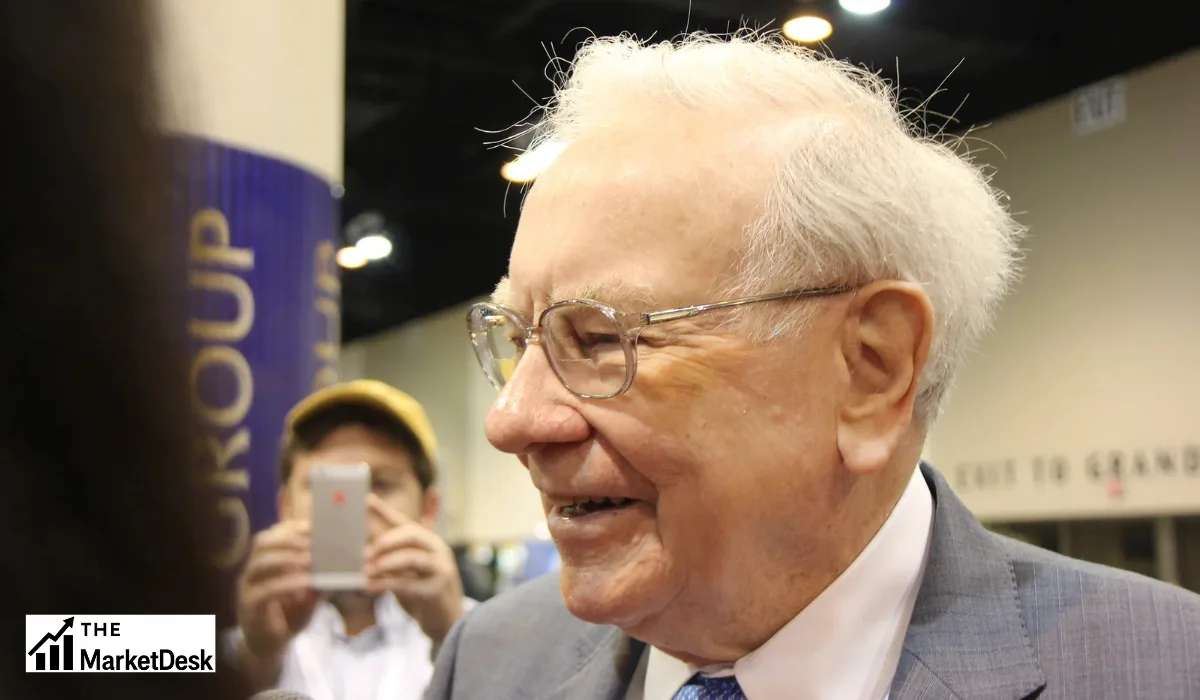Warren Buffett's Enduring Influence on Equity Markets
Warren Buffett's tenure as CEO of Berkshire Hathaway has shaped modern investing. Since taking the helm in 1965, the conglomerate under his leadership has grown into a $900 billion powerhouse. His strategy emphasizes long-term value, steering clear of short-term Wall Street noise.
Berkshire avoids quarterly analyst calls, underscoring Buffett's independence. Yet, as he nears retirement in early 2026, attention turns to his portfolio's future performance. Analysts continue to scrutinize holdings, identifying opportunities even post-transition.
In Q2 2025, Berkshire managed a $332 billion equity portfolio. Amid net sales, select positions drew bullish forecasts. Three stand out for projected 12-month gains: Charter Communications, Jefferies Financial Group, and Constellation Brands.
These stocks reflect diverse sectors—telecom, finance, and consumer goods. Each faces unique 2025 headwinds, from earnings misses to tariffs. However, consensus targets imply rebounds, aligning with Buffett's focus on undervalued assets.
The Broader Context of Berkshire's 2025 Portfolio Strategy
Berkshire's Q2 2025 13F filing revealed continued trimming in core holdings like Apple and Bank of America. This marked the 11th straight quarter of net sales, totaling over $50 billion since late 2022. Such moves signal caution amid elevated valuations.
Despite sales, Buffett added to select names, including Constellation Brands. Smaller stakes like Jefferies Financial Group held steady at $23 million, a mere 0.007% of the portfolio. Charter Communications, reduced by 46.5%, now comprises under 1%.
These adjustments coincide with macroeconomic shifts. Inflation cooled to 2.5% in September 2025, but tariffs under the Trump administration added uncertainty. Unemployment hovered at 4.2%, pressuring consumer sectors.
Buffett's approach remains consistent: buy quality at discounts, hold indefinitely. As Greg Abel assumes CEO duties, continuity in investment philosophy is expected. Analysts view these three stocks as beneficiaries of that ethos.
Charter Communications: Telecom Giant's Rebound Potential
Charter Communications operates as the second-largest U.S. cable provider under the Spectrum brand. Founded in 1993 and headquartered in Stamford, Connecticut, it serves 32 million customers across 41 states.
The company blends broadband, video, and mobile services. In 2024, broadband drove 60% of revenue, totaling $54.6 billion annually. Mobile lines grew 20% year-over-year, reaching 9.5 million by Q2 2025.
Q2 2025 Earnings: A Disappointing Turn
Charter's Q2 results, released July 24, 2025, fell short. Earnings per share hit $9.18, missing estimates of $9.58 by 4.2%. Revenue dipped 1.2% to $13.6 billion, pressured by broadband losses.
Customer relationships declined 0.5% to 31.8 million. Broadband subscribers dropped 139,000, the steepest quarterly fall since 2020. Video subscribers shed 523,000, reflecting cord-cutting trends.
Mobile added 282,000 lines, but ARPU fell 2% to $45 amid promotional pricing. Adjusted EBITDA shrank 3.1% to $4.8 billion, with margins at 35.3%.
CEO Chris Winfrey cited economic softness and competition from fixed wireless access. Charter invested $1.2 billion in network upgrades, targeting 85% DOCSIS 3.1 coverage by year-end.
Analyst Optimism Amid Sector Challenges
Wall Street's view contrasts recent weakness. Of 22 analysts surveyed by S&P Global in October 2025, 10 rate Charter a "buy," eight "hold," and four "sell" or "underperform."
Consensus 12-month price target stands at $410.59, implying 48% upside from the October 7 close of $276.48. High-end forecasts reach $500, low at $230.
RBC Capital's Jonathan Atkin cut his target to $325 from $370 but held "sector perform." KeyBanc's Brandon Nispel lowered to $430 from $500, maintaining "overweight."
Analysts highlight Charter's scale and cash flow. Free cash flow hit $1.5 billion in Q2, supporting $2.2 billion in dividends and buybacks. Debt stands at $96 billion, with leverage at 3.8x EBITDA—manageable for the sector.
Competitive Landscape and Growth Drivers
Charter competes with Comcast, AT&T, and Verizon. Fixed wireless from T-Mobile and Verizon erodes rural broadband. Yet, Charter's hybrid fiber-coax network offers gigabit speeds to 95% of homes.
Mobile convergence bundles drove 40% of Q2 adds. Partnerships with Cox Communications expand reach. Analysts project 2-3% revenue growth in 2026 as economic recovery boosts ARPU.
Regulatory risks loom, including net neutrality debates. However, Charter's $28 billion market cap undervalues its $10 billion annual EBITDA, per value metrics.
Buffett's 46.5% Q2 trim—from 3.4 million to 1.8 million shares—valued at $500 million, suggests tactical caution. Still, the stake's longevity since 2016 signals underlying conviction.
Jefferies Financial Group: Financial Sector's Underdog
Jefferies Financial Group, founded in 1962, ranks as a mid-tier investment bank. Headquartered in New York, it operates globally in advisory, underwriting, and asset management.
The firm manages $500 billion in assets, focusing on middle-market deals. In 2024, revenue reached $7.01 billion, up 49% year-over-year. Net income surged 156% to $669 million.
2025 Performance: Volatility in a Rebounding Market
Jefferies' stock has been turbulent in 2025. From a Q3 2022 entry point, shares rose 80% through 2024. But year-to-date, it's down 15%, closing at $50.89 on October 10.
Q2 earnings showed mixed signals. Revenue fell 5% to $1.8 billion, but advisory fees jumped 25% on M&A revival. Equity underwriting weakened 30% amid IPO slowdowns.
Asset management grew 12%, with $6.5 billion in new capital. Exposure to First Brands bankruptcy, announced September 29, 2025, caps potential losses at $44.6 million, per Morgan Stanley.
The stock trades near its 52-week low of $39.28 in April, 29% below highs. Market cap sits at $10.5 billion, with a forward P/E of 8.5—below peers like Goldman Sachs at 12.
Wall Street's Divided Yet Upbeat Targets
Five analysts split views in October 2025. One "buy," three "hold," one "sell." Consensus target: $66.00, a 30% premium to current levels. Bullish calls hit $74, implying 45% gains.
Morgan Stanley raised to $74 from $72, citing equal-weight potential. BMO initiated "market perform" at $60. Oppenheimer's Chris Kotowski targets $83.72, highest among 20 forecasts.
Dealmaking rebound fuels optimism. Q3 advisory hit records, with $2 trillion in global M&A projected for 2026. Jefferies' 15% middle-market share positions it well.
Regulatory easing under Trump could boost underwriting. The firm's 2.5% dividend yield adds appeal, paid quarterly since 2018.
Buffett's Modest Bet and Long-Term Fit
Berkshire's $23 million stake—433,000 shares—dates to Q3 2022. At 0.2% ownership, it's pocket change for Buffett. No changes in Q2 2025 reflect steady holding.
This aligns with Buffett's financial picks like Bank of America. Jefferies' ROE of 6.6% and 7.7% margins echo value traits. As rates stabilize at 4.25%, lending could accelerate.
Constellation Brands: Navigating Tariffs in Premium Beverages
Constellation Brands leads in imported beer, wine, and spirits. Based in Rochester, New York, it holds exclusive U.S. rights to Corona, Modelo, and Pacifico from Mexico.
Beer accounts for 78% of sales, with $7.5 billion in 2024 revenue. The firm operates breweries in Mexico and Nava, exporting 90% to the U.S. Wine and spirits add diversification.
Tariff Headwinds and Stock Pressure
2025 tariffs hammered Constellation. Trump's 25% levy on aluminum cans and canned beer imports, effective April 4, raised costs 15% on key products.
Aluminum, 70% of can weight, faces 50% duties since June. This added $300 million to expenses, per Q1 estimates. Shares plunged 37% year-to-date to $141.33 on October 10.
Q2 earnings, October 6, showed resilience. EPS beat at $3.45 versus $3.20 expected. Revenue rose 2% to $2.5 billion, led by 5% beer volume growth.
Modelo overtook Bud Light as top U.S. brand, with 12% market share. Hispanic consumers, 50% of base, drove demand despite immigration concerns curbing outings.
Strong Analyst Backing for Recovery
Twenty-five analysts lean positive in October 2025. Fifteen "buy" or "strong buy," eight "hold," two "sell." Consensus target: $191.28, 35% above current price.
Highs reach $233, lows $142. Evercore ISI holds "buy" at $205. Wells Fargo cut to $155 but kept "overweight." Barclays trimmed to $147, "hold."
Premiumization trends support forecasts. Beer's 8% operating margin outpaces wine's 15% decline. Q2 guidance: 4-6% beer sales growth for FY2026.
Dividend yield at 2.9%, with 12x forward P/E, attracts value hunters. $1.2 billion buyback authorized aids support.
Buffett's Growing Confidence
Berkshire initiated in Q4 2024 with 5.6 million shares ($1.24 billion). Q1 and Q2 adds doubled to 12 million, now 7.6% ownership worth $2.2 billion.
This 0.6% portfolio slice bucks net sales trend. Buffett favors durable brands; Modelo's cultural entrenchment mirrors Coca-Cola's moat.
Tariffs pose risks, but diversification into spirits like Svedka mitigates. Analysts see 10% EPS growth in 2026 as duties stabilize.
Comparing the Three: Upside and Risks
| Stock | Current Price (Oct 2025) | Consensus Target | Implied Upside | YTD Performance | Key Risk |
|---|---|---|---|---|---|
| CHTR | $276.48 | $410.59 | 48% | -25% | Subscriber churn |
| JEF | $50.89 | $66.00 | 30% | -15% | Deal volatility |
| STZ | $141.33 | $191.28 | 35% | -37% | Tariff escalation |
Charter leads in projected gains, fueled by network investments. Jefferies offers balanced risk-reward in finance. Constellation provides defensive consumer exposure.
Why Constellation Brands Stands Out Long-Term
Among the trio, Constellation emerges as Buffett's premier value play. Tariffs sting, but premium brands endure. Corona and Modelo's 25% U.S. import share withstands pressure.
Forward P/E of 12 undervalues 15% earnings growth forecast. Dividend growth since 2016 compounds returns. As Hispanic demographics expand—projected 20% of U.S. by 2030—demand persists.
Unlike telecom's churn or banking's cycles, beverages offer stability. Buffett's doubling down signals multi-year horizon, echoing past winners like See's Candies.
Final Thoughts on Buffett's Legacy Picks
These stocks embody Buffett's tenets: strong moats, fair prices, patient capital. As markets navigate 2025 uncertainties, analyst targets suggest outperformance. Investors should weigh personal risk tolerance.
Berkshire's transition ensures continuity. Monitoring Q3 13F, due November 2025, will clarify trajectories.







